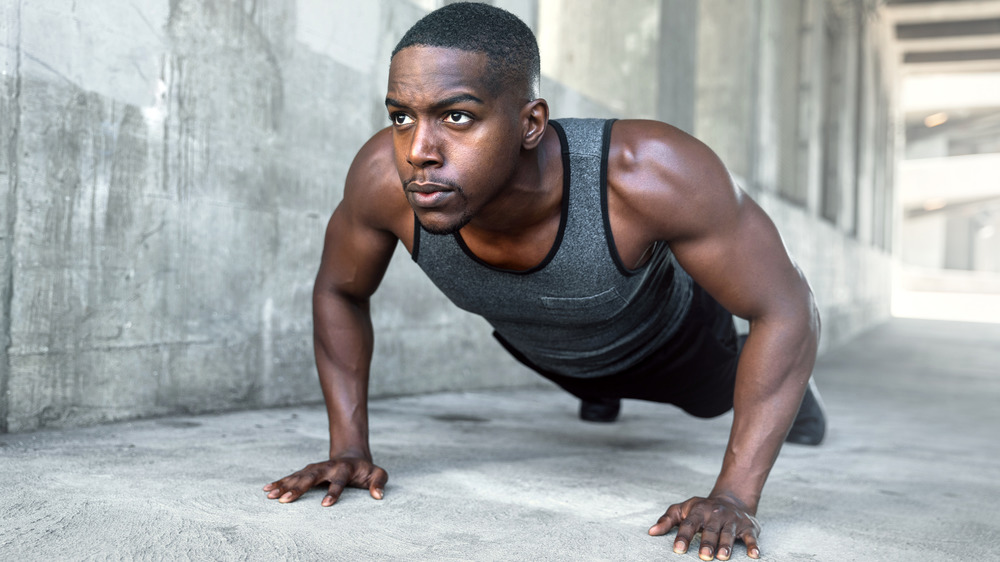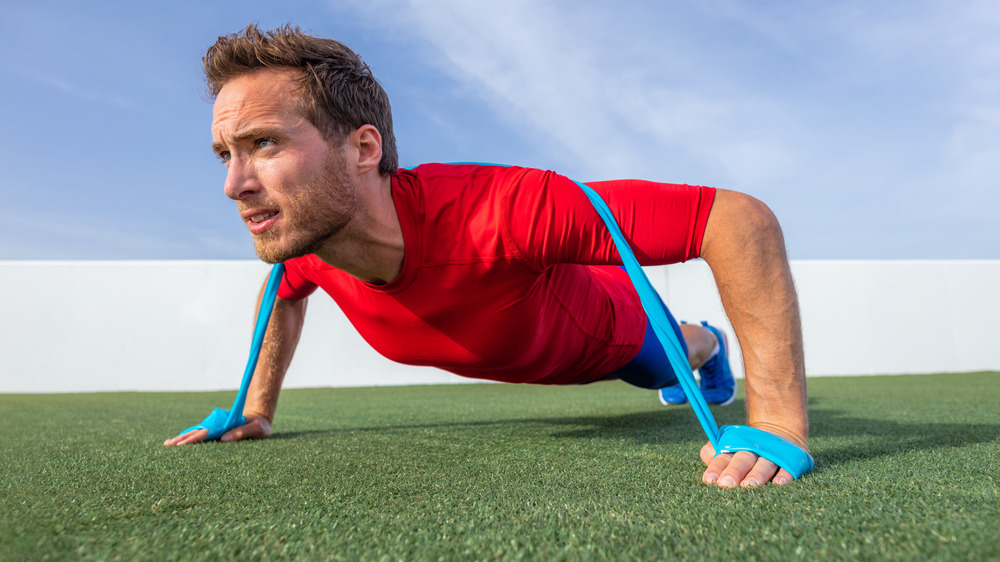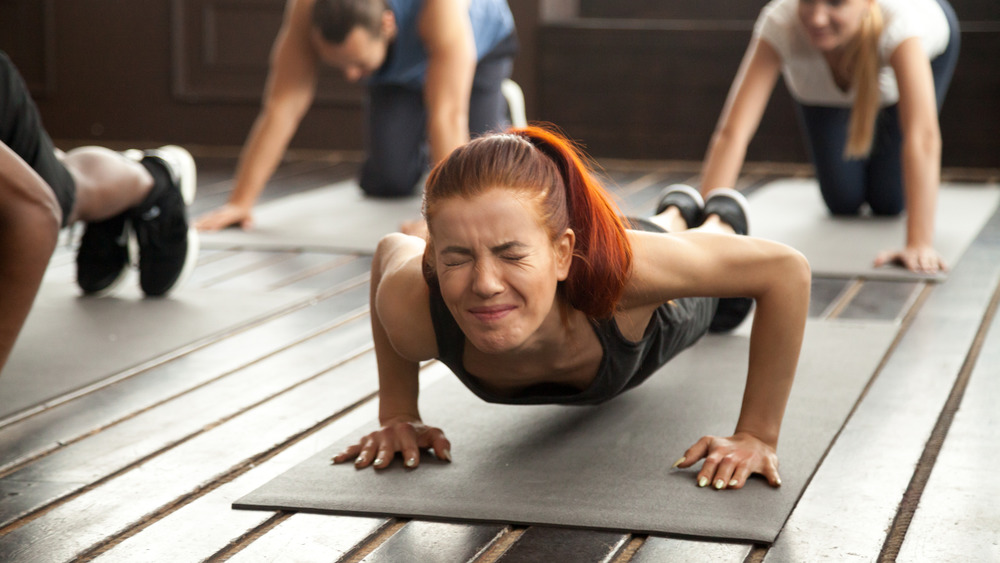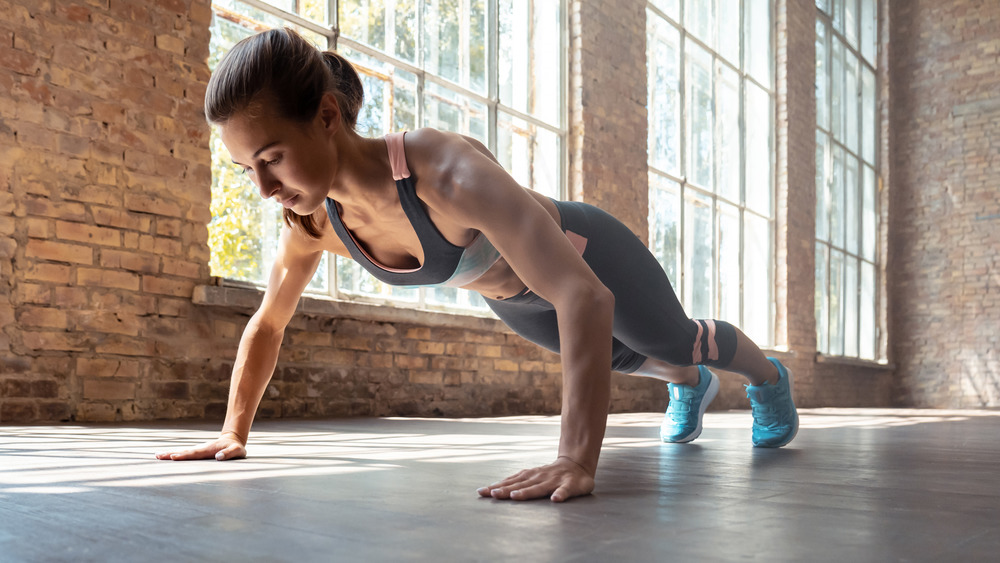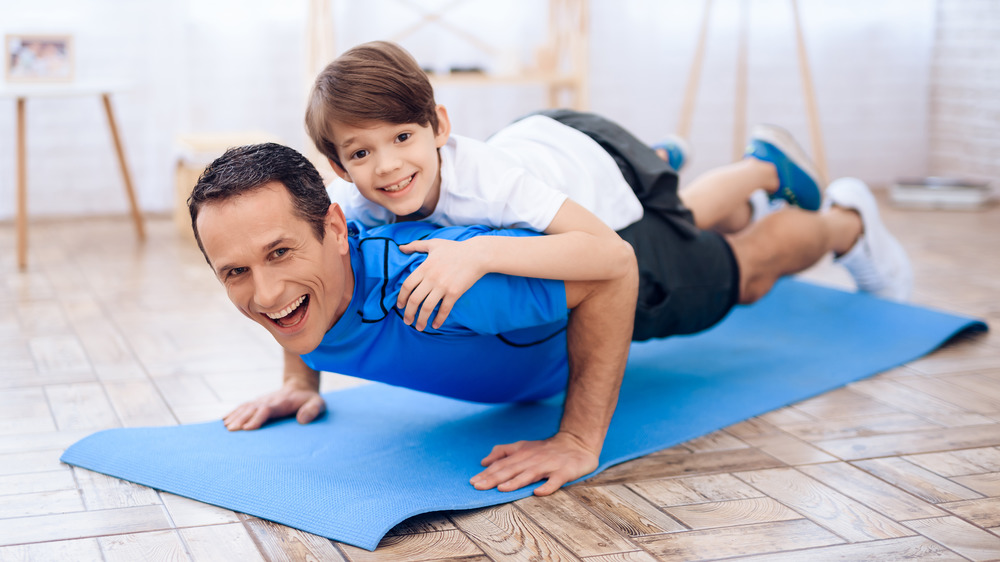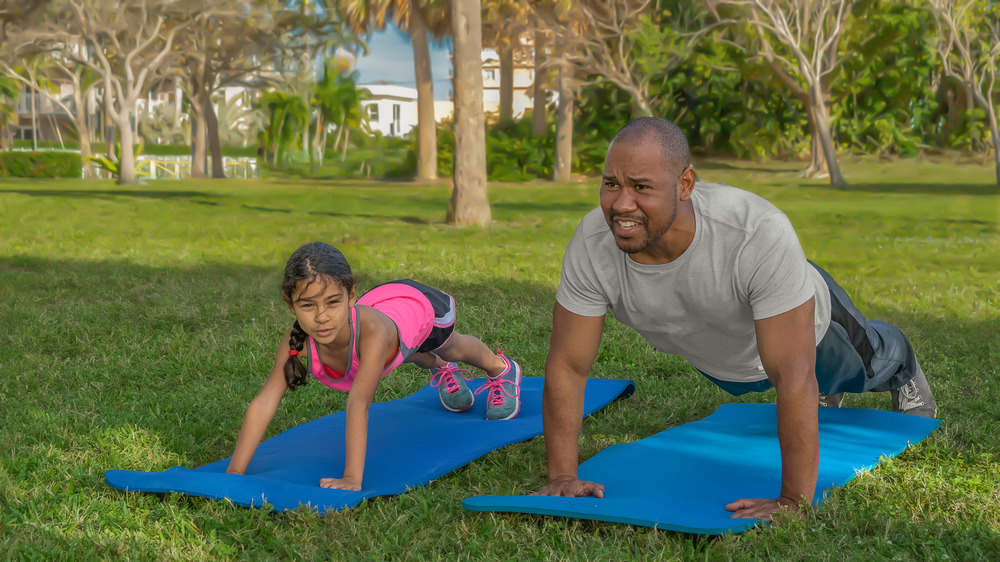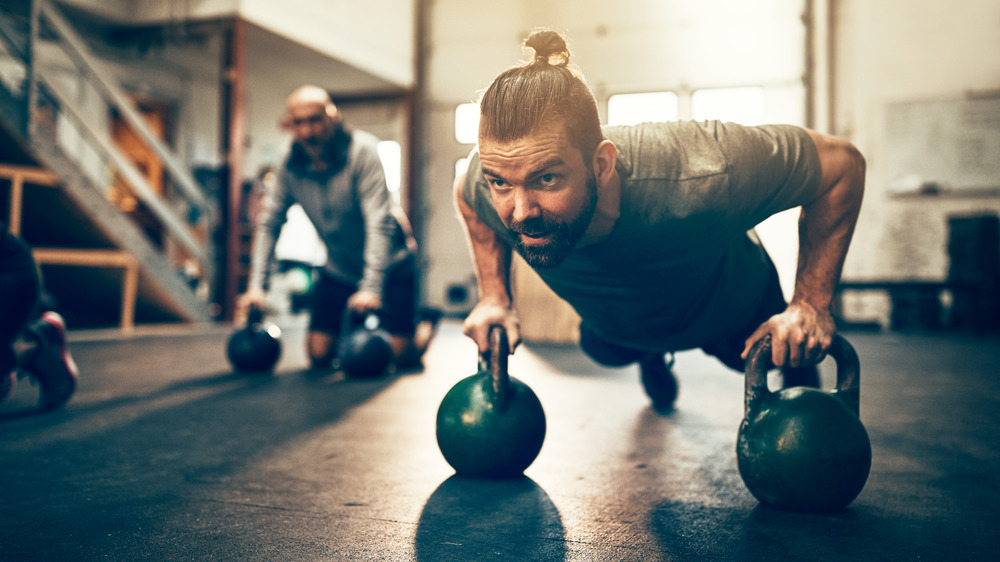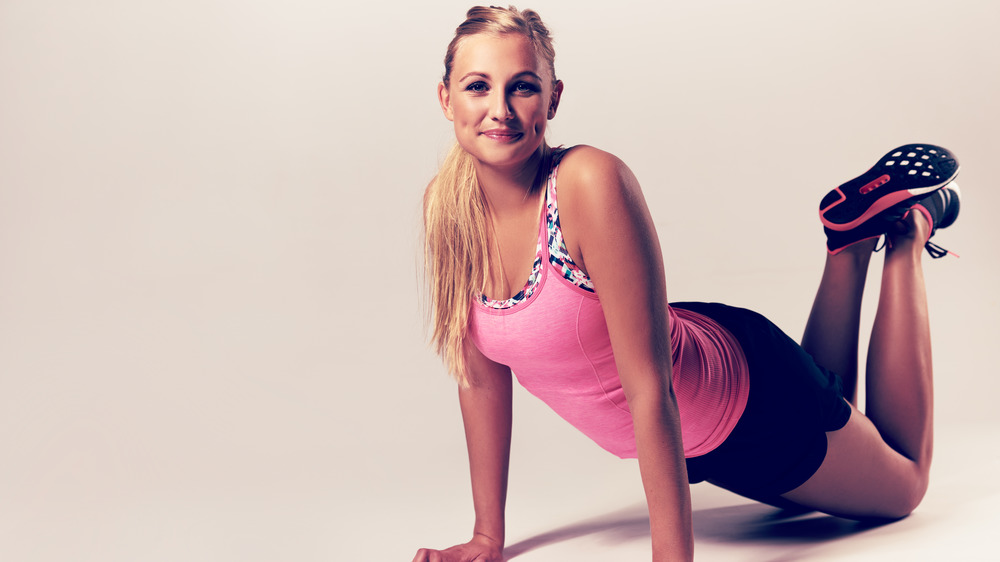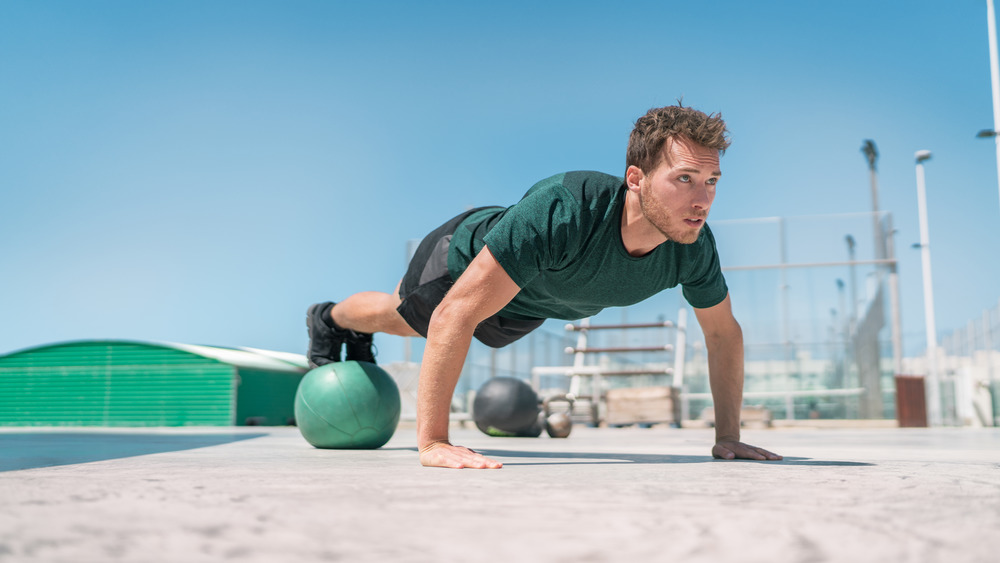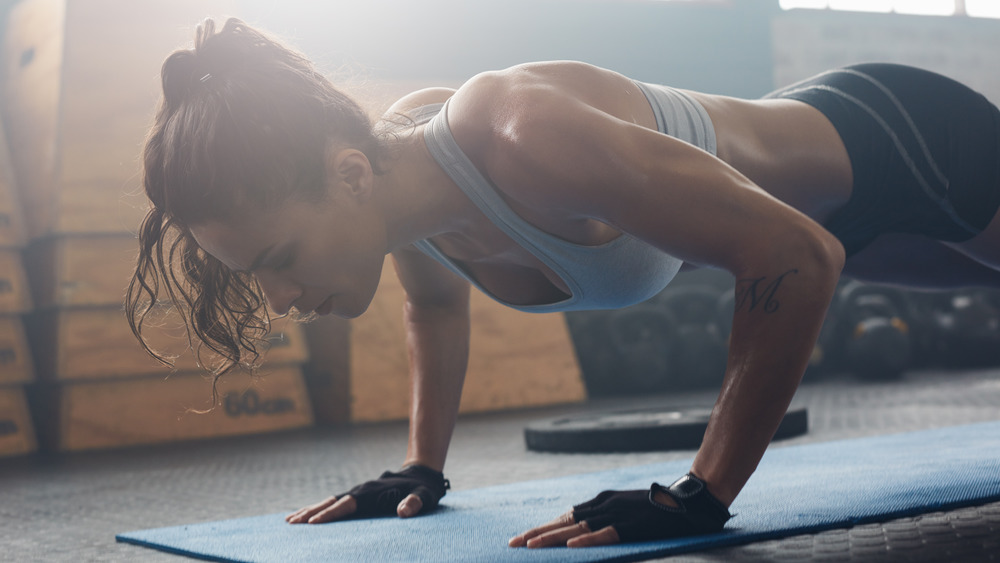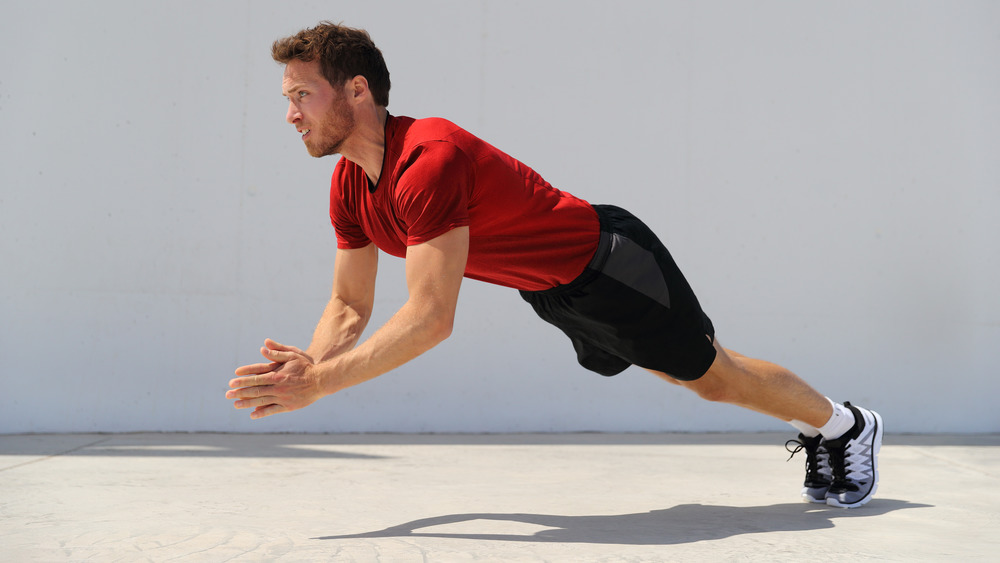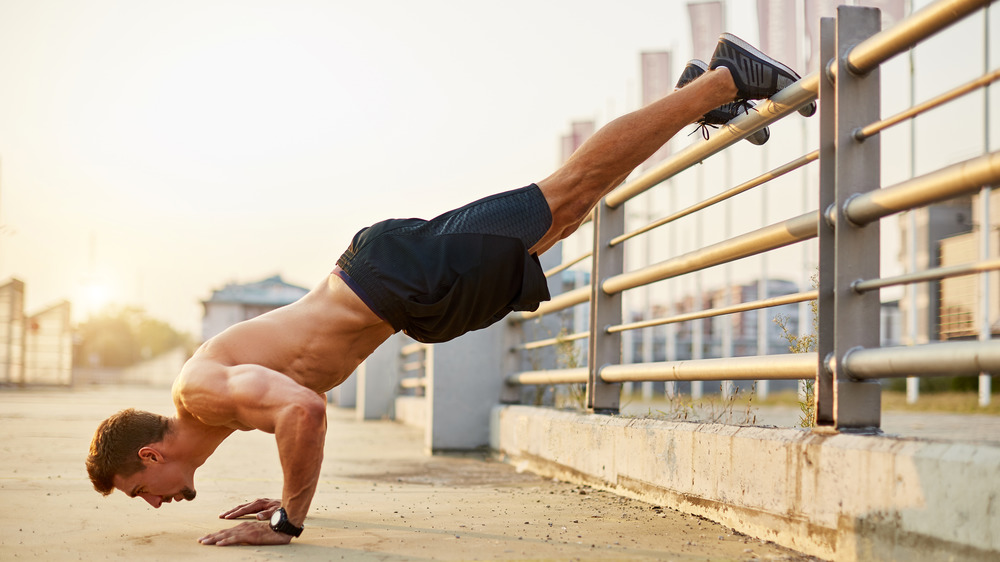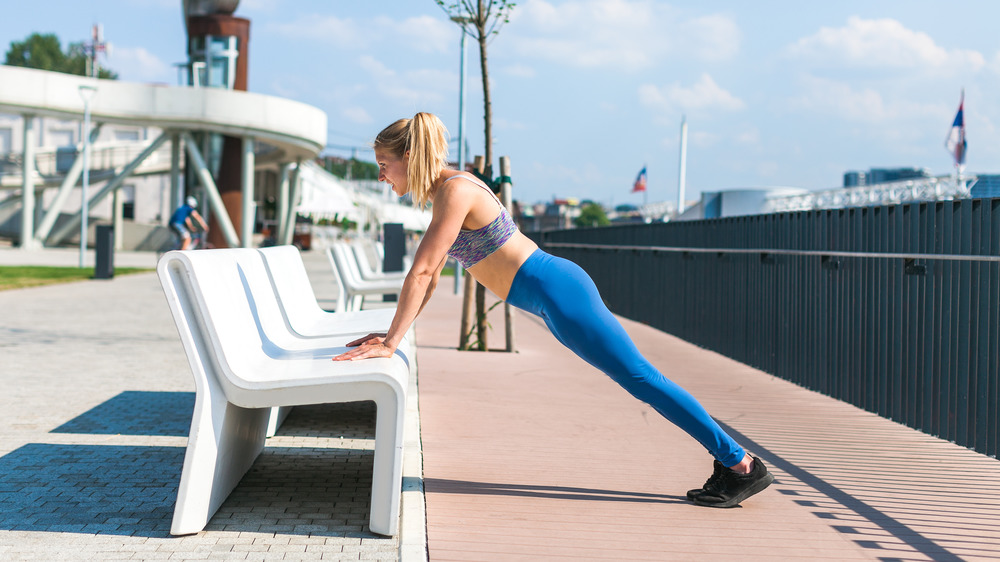The Worst Pushup Mistakes Everyone Makes
Pushups are an excellent way to develop strength through your chest, shoulders, triceps, and core, all without needing any extra equipment. According to Verywell Fit, the exercise even engages the muscles of your legs, which makes sense as you have to involve your quadriceps and glutes to hold the proper pushup position. This makes it a good exercise to add to a home-based full-body strength training routine as one of your primary exercises, or to use as a warm-up for other upper body resistance moves, like the bench press, shoulder press, or triceps press-downs.
The problem, however, is that even though pushups are a well-known move that most people have used at some point in their lives, compound exercises like this (exercises that require coordination and engagement of multiple muscle groups and joints) are often performed incorrectly. It may be because of poor body placement, lack of strength in key muscles, or a simple misunderstanding of proper form. Regardless, most of these blunders are easy to fix once you're aware that you may be making them. Consider the following mistakes before you perform your next set of pushups.
Mistake: Flaring your elbows
To perform a basic pushup, you'll begin by placing your hands on the floor, aligned with your shoulders. "The optimal position for a pushup is to keep the elbows 45 degrees from the body, creating an arrow shape," Chelsea Aguiar, a New York City-based personal trainer, told MyFitnessPal. You shouldn't tuck your elbows right in next to your sides (this positioning targets the triceps more than the chest), and you shouldn't allow your elbows to splay or "flare" outward at 90 degrees, which places more stress on the shoulders. "The most common injury from pushups is pain or pinching in the front of the shoulder," Aguiar continued.
If you make this mistake, know that it's easy to fix. First, make sure your palms are placed directly under your shoulders as you set up for your pushups. Then, as you do your pushup, think "arrow," and consciously aim your elbows back at a 45-degree angle. It's really that simple. But if you can't tell where your elbows are pointing, try using a mirror or recruit a friend to help you make any necessary adjustments.
Mistake: Positioning your hands too far apart
Okay, it's true there is a type of pushup that's designed to have a wide hand placement, but beginners or those looking to rebuild strength after a break are not the ones who should be trying this variation.
Adam Scott, a strength and conditioning coach for Mountain Athlete, told Outside, "[Many novice athletes] are convinced that a wider hand position will give them more strength and stability, but this position actually does the opposite — wide hands and bowed elbows force you to shrug your shoulders and contort your elbows." And while you may be tempted to "cheat" with a wider hand placement — your chest has less space to move between the starting position and the floor, after all — you might be setting yourself up for shoulder pain.
Instead, place your hands directly under your shoulders and keep your back and shoulders fully engaged — don't allow your shoulders to cave or your back to collapse. If you find this hand position more difficult, that probably means you're doing it right. You can, however, safely modify the exercise to make it easier by lowering your knees to the ground or placing your hands on a bench (via Self).
Mistake: Craning your neck
When it comes to how people position their heads while doing pushups, there are two common mistakes: craning the head and neck upward while looking forward or allowing the head and neck to drop down toward the floor between the arms. According to personal trainer Sam Downing, writing for The Sydney Morning Herald, this latter problem is particularly common in women who are trying to recruit their neck and upper back muscles to offer an assist with performing the exercise.
No matter which mistake you personally fall prey to, it'll throw your spine out of alignment and place added stress on your neck and upper back. To fix the problem, you want to think about keeping an absolute "straight line" between the top of your head and your ankles as you perform each pushup, Downing explained. This neutral neck position will ultimately help protect your spine and keep the focus of the exercise on your chest, shoulders, and triceps, as intended.
Mistake: Performing a partial range of motion
It's tempting to pump through a set of pushups without going through a full range of motion. The reality is, pushups are hard! And who is it hurting, really, if you do a half range of motion instead of lowering your chest almost all the way to the floor? Well, it will at least hurt your workout.
Adam Scott, a strength and conditioning coach for Mountain Athlete didn't mince words when speaking with Outside, pointing out there are top-half cheaters and bottom-half cheaters with pushups. Those who stay in the upper range of the pushup may have less upper body strength and struggle to perform a full pushup, while those who tend to stay in the bottom range may have more strength but may not have the strength to complete as many pushups, or "full" pushups, as they'd like to believe. "Unfortunately for you, 100 half push-ups equals 0 push-ups," said Scott.
The fix is easy: Always perform a full pushup. This means bending your elbows from a fully extended 180 degrees to at least 90 degrees with each rep. "If you can't quite the full range of motion, try going to your knees or elevate your hands until you've found a light enough position," Scott advised.
Mistake: Letting your hips sag
When your hips sag during a pushup, that's a surefire sign that you lack the core strength necessary to maintain proper spinal alignment during the exercise. You may have experienced this when doing a set of 10 pushups. Maybe you're able to keep perfect form for the first six reps, but you just can't quite seem to keep your hips lifted for the last four.
This is a very common problem, but as NASM-certified personal trainer Cori Lefkowith told MyFitnessPal, this form puts a lot of pressure on your lower back while also cheating you out of developing the abdominal strength necessary to keep getting better at pushups. If you find your lower back and hips sagging at any point during your pushup routine, start by trying to re-engage your abs and "tuck" your pelvis under. If you just can't seem to hold the proper form, switch to a modified pushup to finish off your set. You can drop your knees to the ground or switch to an incline pushup with your hands placed on a bench or sturdy piece of furniture.
Mistake: Raising your butt
A very common way to "cheat" while doing pushups is to flex a bit at the hips, pressing your glutes up higher, "breaking" the straight line you want to create between your heels and your head.
Charlee Atkins, certified strength and conditioning coach, explained in an article for Well+Good that this form, "butt up in the air," is one of the most common mistakes she sees. When you create this breaking point, you're essentially limiting the core engagement a full pushup requires and reducing the weight you'd typically be placing on your chest and shoulders, as your legs take on more of this resistance.
To fix the mistake, start in a full plank position (via Self). Be sure to check your form in a mirror or get input from a friend. Your hips should be directly aligned between your ankles and shoulders. Maintain this perfect plank position as you move through the full range of motion of your pushup. If you find you can't perform a full set without resorting to this cheat, then it's time to modify the exercise and perform your remaining repetition on your knees or in an inclined position.
Mistake: Moving too fast
There's nothing inherently wrong with performing pushups for speed if you're strong enough and have good enough form to do so. But if you're cranking out pushups as fast as you possibly can, there's a decent chance you'll be sacrificing your form to sneak in a few extra reps. And quite possibly more importantly, you may end up sacrificing results.
According to a 2011 study published in the Journal of Medical and Biological Engineering, performing pushups slowly, as compared to medium and fast speeds, appeared to have the greatest muscle activation of the triceps, biceps, shoulders, and chest. The researchers concluded, "[Pushups] should be performed at a slower speed when the aim is to strengthen the upper extremity muscles."
A "slow" pushup speed was considered four pushups every 10 seconds, so 2.5 seconds per pushup. Rather than time your pushups, though, simply think "slow and steady" as you move through your pushups. Not only will this help you get the most value from your pushups, it'll also help you concentrate on form.
Mistake: Crossing your legs when doing modified pushups
If you've ever performed a modified pushup using your knees, chances are you've crossed your ankles before doing your set. It's a form mishap that's seen everywhere — although there's no real rhyme or reason for why it takes place. Even though the result is minor, crossing one leg over the other can misalign your pelvis, placing slightly greater weight on one side than the other. "Keep your feet uncrossed and neutral behind you to keep your pelvis neutral," certified strength and conditioning specialist Chelsea Axe advised in an interview with Insider.
In a Health video tutorial on how to perform the perfect modified pushup, personal trainer Sarah Wingo similarly emphasized that your ankles should remain uncrossed, and you should actually bend your ankles to bring your heels toward your glutes rather than allowing your feet to touch or hover just above the floor. Remember, aside from your knees being on the floor, a modified pushup form is exactly the same as a standard pushup.
Mistake: Not reaching at the top
If you want to take your pushups to the next level, you should focus on fully extending your elbows and even "reaching" beyond the full extension with each repetition. But it's not just your elbows that indicate a fully extended pushup. Rather, it's how your shoulder blades are positioned as well.
"An uncompleted pushup where the shoulder blades remain retracted and wing off the rib cage ... is a very unstable position for your shoulders to be in, making your wrists and elbows work double time to support your body," personal trainer Matt Skeffington explained in an article for Dynamic Strength & Conditioning.
When you protract your shoulder blades, you're essentially adding an extra "push" to your pushup, extending your elbows. And as Skeffington coached, "Think of driving your chest away from the floor." When you perform a pushup this way, you're targeting muscle groups that are often hard to hit, like the serratus anterior and the lower part of the trapezius muscle, in addition to keeping your shoulder position strong.
Mistake: Angling your wrists inward
Just as an improper angle of your elbows can mess up your pushup form, so, too, can the improper position of your palms. When it comes to any exercise, an understanding of proper form comes down to observing how the muscles, bones, and joints work together to achieve a particular movement. And little changes in body position can affect how you're targeting your muscles.
Nick Tumminello, a strength coach, wrote about hand positioning in an article for Breaking Muscle, stating, "If your hands are pointed slightly inward ... it usually encourages people to flare their arms out away from their sides." He continued, writing, "Pointing your hands inward also forces your elbows to move out beyond your wrists."
The fix is easy. As Tumminello explained, "Turn your hands outward slightly, pointing your fingers outward, away from the middle of your body at roughly a 45-degree angle." By positioning your hands correctly rather than angling them inward, you more effectively prevent injury or pain by reducing stress on your wrists, elbows, and shoulders.
Mistake: Hunching your shoulders
Unlike some of the other most common pushup mistakes, hunching or "shrugging" your shoulders isn't typically associated with incorrect body position. Rather, it's associated with fatigue (via Men's Health).
As your upper body gets tired — especially as you're transitioning between the downward and upward phases of the movement — you may find yourself shrugging your shoulders up toward your ears or collapsing your scapulas together and in toward the spine to try to "force" yourself back to the starting position. This may help you pump out a couple more reps, but as pointed out by Men's Health, this position ultimately jeopardizes your stability, which can contribute to injury.
As kinesiologist and fitness influencer Jeremy Ethier told Men's Health, "Activate your lats, actively pull your shoulders down and away from your ears into a stable and locked position. This simple change will add a ton of much-needed stability to your pushup, improve your pushing strength, and ensure that most of the tension goes towards the target muscle."
Mistake: Forgetting about your breathing technique
Breathing correctly while strength training is incredibly important. For one thing, holding your breath is a big no-no. Breathing helps your heart deliver oxygen-rich blood and nutrients to your working muscles, which is precisely how your body generates energy for movement (via Self). But beyond that, correct breathing technique can help you power through each individual repetition. As advised by Livestrong, "Exhale during the hardest part of the exercise ... and inhale on the opposite movement."
In the case of pushups, this means you should inhale as you lower your chest toward the floor and exhale as you press your body back up to the starting position. And if you find yourself short of breath or are experiencing shallow breathing (this is particularly normal as you start to get tired), focus on diaphragmatic breathing, which is a deep form of breathing that moves your diaphragm downward and into your belly with each breath (via Livestrong). If you can't catch your breath or you find yourself dizzy or lightheaded, take a break. You can always continue your set once you've allowed yourself time to recover.
Mistake: Not trying variations
Once you've progressed to performing full pushups without a problem, your pushup routine can start to get interesting. There are a multitude of pushup variations that you can try once you've developed the coordination and strength to perform full pushups well. For instance, you can place your feet on a raised surface to perform a decline pushup. You can place one hand (or both!) on a stability ball to recruit your core and stabilizing muscles more. You can switch up your hand position or your elbow position to target your muscles from slightly different angles (via Verywell Fit). The possibilities are nearly endless.
Writing for Breaking Muscle, strength coach Nick Tumminello revealed that his favorite variations add new movement patterns to the basic pushup — like the superman pushup, which involves extending the opposite arm and leg and lifting them from the floor between each pushup.
However, you shouldn't try to do multiple different pushup variations in a single workout. Tumminello suggested choosing one variation per session, aiming to perform two to four sets, completing as many reps as possible per set with good form. And remember, rest is important. Allow 90 to 120 seconds of rest between sets.
Mistake: Dismissing modifications
If you think there are only two ways to do a pushup — from a plank position to on the knees — you're missing out on the benefits of a great modification: the inclined pushup. Not everyone has the strength to crank out three sets of 20 repetitions of full pushups, but if you're able to do even one or two full pushups with perfect form, you might want to mix in incline pushups and knee pushups to help you progress.
As celebrity trainer Lacey Stone told Self, knee pushups are the most challenging modification for your upper body, but developing chest strength isn't the only thing you should be thinking about when trying to progress your pushups. Unlike a knee pushup, an incline pushup is performed from the plank position, requiring you to use your quads, glutes, and core to help maintain stability.
With a knee pushup, you shorten the lever, so to speak, taking some pressure off of your core. By doing knee pushups and incline pushups you can develop all of the different areas of strength necessary to eventually crank out those three sets of 20 full pushups.

